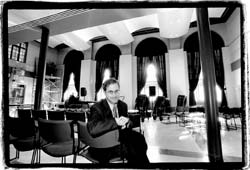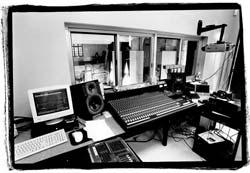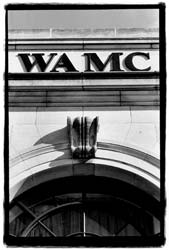


Arts
Feature
Bank
On It
The
next phase of public radio station WAMC’s evolution: reinventing a bank
building as a theater suited to every kind of live performance
By
Kate Sipher
Bank On It
The next phase of public radio station WAMC’s evolution: reinventing a bank building as a theater suited to every kind of live performance
By Peter Hanson • Photographs by Leif Zurmuhlen
 And
now, after nine months of construction and an investment of $1.3 million—including
the comparatively miniscule $75,000 cost of the building—the project has
almost reached fruition. As Chartock and two of his lieutenants tour the
nearly complete facility, WAMC’s effusive executive director captures the
mood by describing the facility as “beyond our wildest expectations.” He
then adds that the ambitious project reflects the station’s upward velocity:
“Who said we were going to be the second-largest producer of public-radio
programming in the country? But we did it.”
And
now, after nine months of construction and an investment of $1.3 million—including
the comparatively miniscule $75,000 cost of the building—the project has
almost reached fruition. As Chartock and two of his lieutenants tour the
nearly complete facility, WAMC’s effusive executive director captures the
mood by describing the facility as “beyond our wildest expectations.” He
then adds that the ambitious project reflects the station’s upward velocity:
“Who said we were going to be the second-largest producer of public-radio
programming in the country? But we did it.”
Formally named the WAMC Performing Arts Studio, the facility was designed for optimum flexibility. The main space, a two-story-high expanse called the Linda Norris Auditorium, can contain as many as 226 seats, but neither the seats nor the 8-feet-by-16-feet stage are in fixed locations. Instead, seats are rearranged for each performance, as are the four pieces that comprise the stage. The room can be modified for concerts, debates, movie screenings, dances and myriad other events.
“It was designed flexible so we could do a lot of things,” offers David Galletly, an assistant executive director at WAMC. “We just wanted to not close doors for ourselves—remembering, of course, that its primary duty is as a radio studio.”
Each of the four huge floor-to-ceiling windows that line the wall behind the stage has two layers of glass, and thick curtains can be closed to further dampen outside sound. Microphones can be pointed in almost any direction within the studio, and a floor manager will coach performers on how to deliver the most radio-friendly sound. Sonic quality will be overseen from a second-floor control room, which is equipped with such amenities as a video projector, a high-tech security system, and two separate transmitters for sending sound to WAMC’s main studio, located half a block away on Central Avenue.
 The
new facility contains novel remnants of its previous use. The gilded gate
to the safe-deposit vault is as a decorative flourish on an auditorium
wall, and the building’s main vault has been converted into a spacious
“green room”—after primping themselves, performers pass a massive, two-foot
thick Diebold Safe & Lock Co. door before heading out into the performance
space.
The
new facility contains novel remnants of its previous use. The gilded gate
to the safe-deposit vault is as a decorative flourish on an auditorium
wall, and the building’s main vault has been converted into a spacious
“green room”—after primping themselves, performers pass a massive, two-foot
thick Diebold Safe & Lock Co. door before heading out into the performance
space.
Just as the facility’s layout is flexible, so too is its future. A sizable second-floor space has yet to be allocated for any particular purpose, and Chartock suggests that it could be employed for anything from yoga lessons to TV broadcasting. The building itself is TV-compatible, as Galletly explains: “We designed the place with a connection so that a video truck can just pull up and plug in.” The folks from Time Warner Cable’s local-music TV show, Sounding Board, will soon venture to the facility in order to tape an episode featuring children’s entertainers the Zucchini Brothers, who host a WAMC show every weekday afternoon.
Although the opening-week attractions that begin with Monday’s ribbon-cutting ceremony are all free and open to the public, admission eventually will be charged to some events at the new theater. Yet even after people begin paying to get into the facility, it will retain the grassroots quality of the station: Volunteers will serve as ushers, WAMC tchotchkes will be available for purchase at the marble counter just inside the front entrance, and concessions will be available at a small stand in a back corner of the auditorium. The idea is to bring in enough money to cover expenses such as heat and electricity, then pump any extra income into the station’s operating budget.
“I do believe it is in the city’s great interest to have us here,” Chartock says. “Until now, this area has been challenged for cultural offerings.”
 For
the time being, no full-time executive will be recruited to run the facility;
instead, former WAMC receptionist April Kiss is serving as the on-site
organizer during broadcasts. As Selma Kaplan, another WAMC assistant executive
director, points out, the station will watch closely during upcoming events
to see what works and what doesn’t. One experiment that may bear fruit
is inviting national music acts to play on-air gigs while in town for headlining
gigs—or even instead of headlining gigs. “There are a lot of people who
would exact a huge fee to play on a Friday night,” Kaplan says, “but if
you give them a Wednesday night and offer them a chance to be on the radio,
they get added value.”
For
the time being, no full-time executive will be recruited to run the facility;
instead, former WAMC receptionist April Kiss is serving as the on-site
organizer during broadcasts. As Selma Kaplan, another WAMC assistant executive
director, points out, the station will watch closely during upcoming events
to see what works and what doesn’t. One experiment that may bear fruit
is inviting national music acts to play on-air gigs while in town for headlining
gigs—or even instead of headlining gigs. “There are a lot of people who
would exact a huge fee to play on a Friday night,” Kaplan says, “but if
you give them a Wednesday night and offer them a chance to be on the radio,
they get added value.”
Among the ongoing programs that already have been confirmed are kids’ folksinging sessions every Saturday morning and string-quartet concerts every Sunday afternoon. Kaplan says that the plan is to establish certain mainstays on the schedule so that audience members show up week after week. “We’d like people to know there’s going to be children’s folksinging every Saturday, come hell or high water,” she says.
While
the possibility of renting the theater out from time to time still exists,
the WAMC executives note that the schedule is filling up quickly with shows
that will be broadcast live, shows that will be taped for subsequent broadcast,
and even shows that will be featured on the station’s online enterprise,
www.thepublicradio
station.com.
Asked
whether he figures the WAMC Performing Arts Studio will be booked solid
by this time next year, Chartock smiles mischievously. “If you ask me,
the answer is ‘yes,’ ” he says. “If you ask others, they’ll say to shoot
me.”
|

